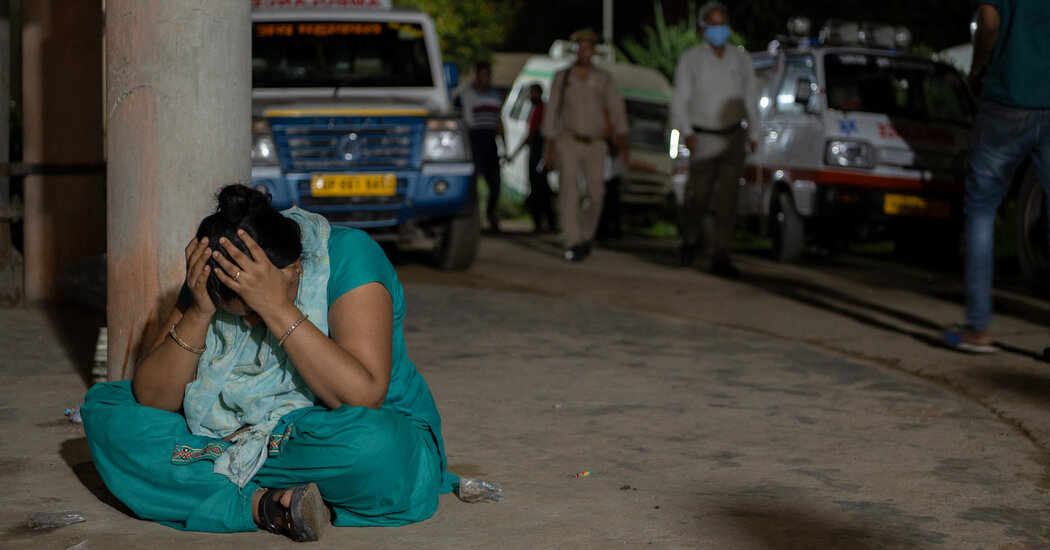One moment, a crowd of tens of thousands, almost all women, were singing and swaying in devotion to a revered holy man in front of them onstage, all packed under a sprawling tent in northern India.
But as the guru left, people began pushing and shoving to get out from the close quarters and still, stifling heat under the pavilion. Some began falling, onto the muddy field underneath or into an adjacent ditch. There was panic and screaming. Bodies piled on top of each other everywhere.
By nightfall on Tuesday, the toll of the tragedy in Hathras district, in the state of Uttar Pradesh, was devastating: at least 121 people, mostly from poor communities, were dead. Dozens were injured.
For the families, the search for the remains of their loved ones brought them to several hospitals and stretched on past midnight.
At the Bagla Combined District Hospital, where 34 victims were taken, the dead bodies lay on melting slabs of ice that lined the corridor. Faces bore the marks of the ghastly stampede from the afternoon — a blob of mud hanging from hair, dried trickles of blood on skin. The corridor’s green carpet was drenched with slush and mud from the shoes and slippers of distraught relatives.
Outside, on the veranda, dozens more slabs of ice were stacked. Ambulances brought in a steady stream of the deceased. A policeman went from body to body, accompanied by relatives, as he jotted details in a red diary. In the early hours of the morning, hospital staff started sanitizing the space, sweeping the melting ice and washing the floors, ahead of V.I.P. visits. “Sprinkle more phenyl,” one official commanded, referring to the floor-cleaning liquid.
A husband, crouched on the wet floor next to his wife’s body, banged his head against the corridor wall. A grandfather clutched at the tiny fingers of his only grandchild. A son stooped over in examination, trying to find his mother’s body.
The hospital’s eerie silence was frequently broken by piercing cries of grief as a victim was recognized.
The holy man — whose real name is Suraj Pal, though he is better known as Narayan Sakar Hari or Bhole Baba — is a former police officer who took early retirement and then fashioned himself as a spiritual guru and began drawing huge crowds.
Villagers said he had become an icon for women of the Dalit community, at the bottom of India’s rigid caste system, who have historically been marginalized as “untouchables” and denied access to temples. He often dresses in white suits with colorful ties, and he and his wife sit on thrones during their sermons onstage. He has built several ashrams, or spiritual centers, in other areas near Hathras, and his following extends to other states as well.
The crowd had arrived for Tuesday’s meeting in buses, trains and taxis before they streamed to a tent erected on farmland near the highway. They had come from all over the state, some walking from neighboring districts. Some had come alone, others with neighbors, friends, children or grandchildren. It was a congregation they absolutely did not want to miss.
An initial police report, filed late Tuesday, said that organizers had permission for 80,000 attendees, a number far higher than what local police officials earlier said was allowed under the permit. The police report accused the organizers, without naming the guru, of lying about the size of the crowd that had eventually gathered, and officials said three times as many people — about 250,000 — had showed up. The police also accused the organizers of trying to hide evidence “by throwing the clothes, shoes, slippers and other things into the crop fields.”
The police report said the stampede had started after the guru left, as devotees “rushed to collect dirt from the path on which his car passed.” Event volunteers used sticks and force to try to hold back the crowd, but pressure kept building, and the stampede broke out.
Hans Kumari, 40, had arrived in a taxi with 10 other women for the gathering. She had begun following Bhole Baba in the hope of receiving a cure for her chronic health issues: pain in her knees and trouble sleeping. Some women in the village had told her the holy man could help, so she started going to his meetings regularly.
“Yesterday we got here early to get a good spot to sit,” she said.
Ms. Kumari said a commotion had started after Bhole Baba finished his sermon, left the stage and was driven away in a vehicle.
“People started running like crazy. It was mostly women,” she said. “I slipped in a ditch and waded over what looked like a bed of dead bodies. I could see two dead women and a child below my feet. Body upon body.”
Ms. Kumari said she made it out, with bruises on her skull and all over her body, by keeping “my head down and hands outstretched to keep cutting through.”
Others weren’t so lucky.
“The bus carrying the devotees was back in the village. My mother was not on it,” said Bunty Kumar, 29, disheveled and teary-eyed after she arrived at the government hospital. “We finally found a picture of her laid on an ice slab on the internet. That’s when we realized she was dead.”
Saudan Singh, 62, a farmer, sat quietly next to the body of his only grandchild, Rehanshu, 2, who was laid out on a slab of ice, his short hair shooting out in all directions. A portion of his yellow T-shirt peeked out from below a white sheet. His father was too distraught to be able to come to identify his body.
Mr. Singh said Rehanshu had come on a bus with his mother, who was a devotee and frequently attended the spiritual revivals. He lost both of them.
“He came with his mother on a bus,” Mr. Singh said. “She had attended many of his sermons earlier. I had also attended some. He teaches us about brotherhood, humanity, peace and love.”
His grief was palpable as he described his love for the mischievous child. “My grandson called me ‘baba,’” he said. “He demanded sweets, bananas and biscuits of me.”
Mujib Mashal and Hari Kumar contributed reporting from New Delhi.




